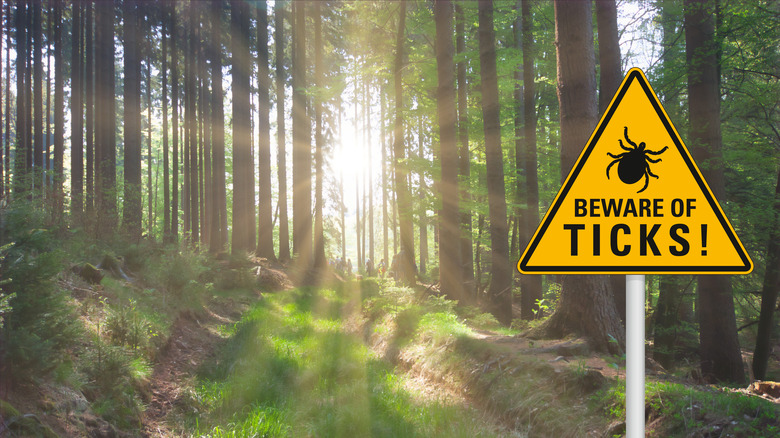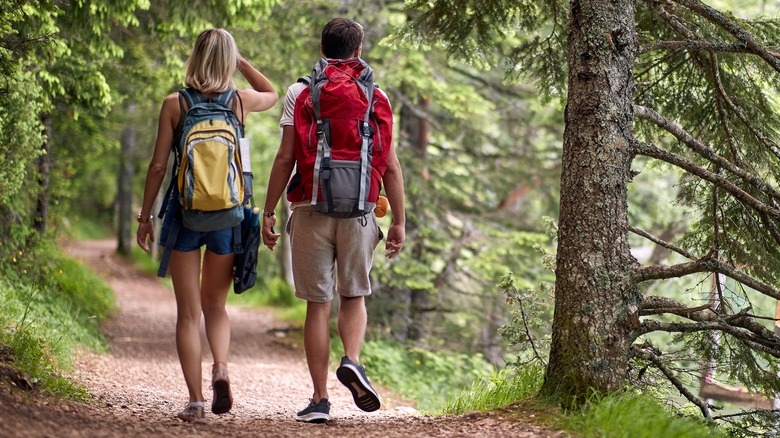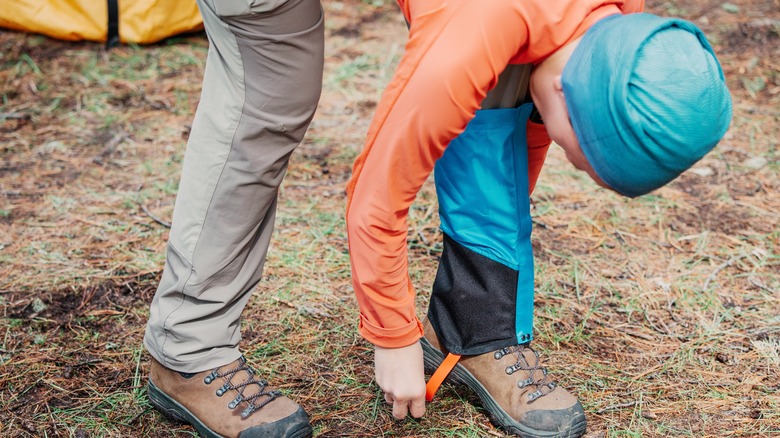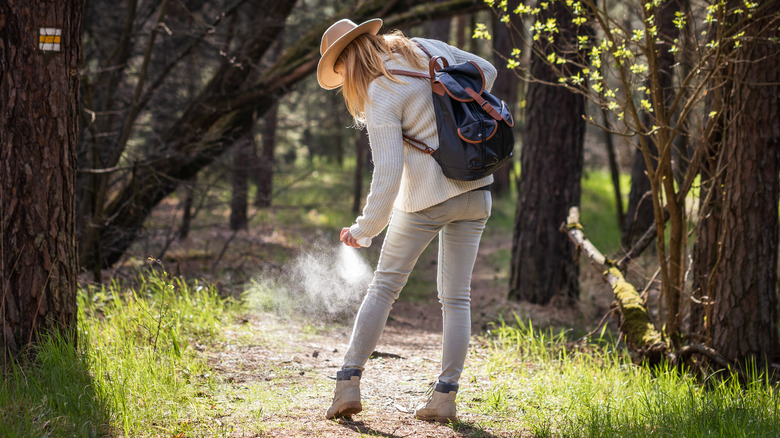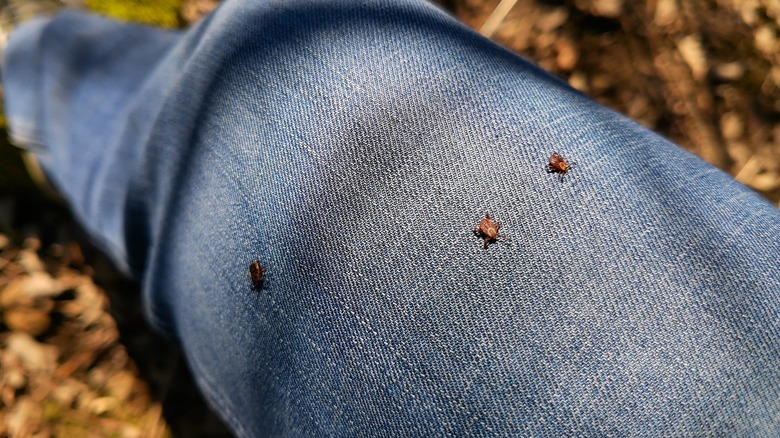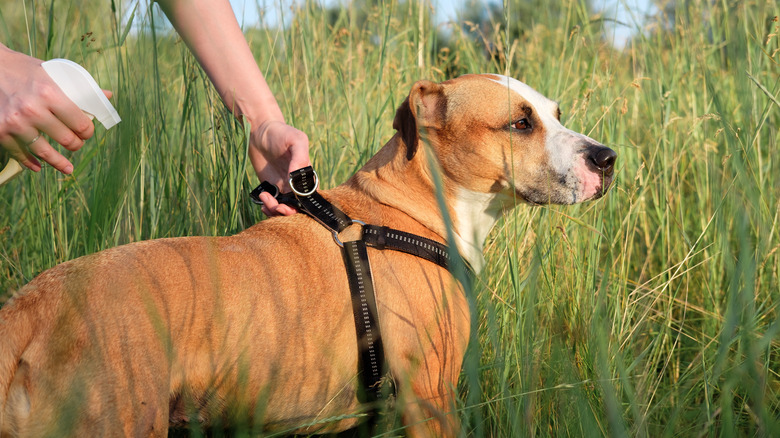Simple Tricks To Avoid Tick Bites On Your Next Hike
Hiking is a top-tier summer activity. Whether you're looking to explore a new ecosystem, raise your heart rate, commune with nature, or all of the above, a rigorous (or relaxing) hike is a wonderful way to recharge. However, there's one creepy-crawly ready to suck the joy out of an otherwise good experience — ticks.
Ticks aren't just gross; they're also dangerous. Along with other diseases, ticks can carry Rocky Mountain Spotted Fever, which can be deadly, and Lyme disease, which is dangerous if left untreated. While the risk of getting a disease from a tick bite is relatively low, why risk it at all?
Ticks can be found in all 50 U.S. states and around the world, so completely avoiding them while hiking is difficult. Apart from snowshoeing and hiking in freezing temperatures, you'll probably be around some ticks. Fortunately, there are a few easy tips to follow to avoid these pesky blood-suckers.
Stay in the middle of hiking paths
While you'll find ticks pretty much everywhere, they really like to crawl around in tall grass, thick brush, and other forms of forest debris. A common misconception about ticks is that they jump like fleas. They don't. Ticks simply sit around on grass or something similar until they find a host to crawl or fall (and latch) onto.
By sticking to the middle of hiking trails, you're less likely to bump into tall grass, brush, leaf litter, and side-trail overgrowths where ticks typically hang out. Although that picturesque meadow may seem like an enticing off-trail detour, with breeze-swayed grasses and colorful wildflowers, you should be aware of the heightened risk of ticks.
The same tip goes for when you take a break. If you need to sit down for a bit, try to find a log or boulder to sit on. If you have no choice but to sit on the ground, try not to sit in the grass or near forest debris. The more barren your seat, the less likely you'll pick up a hitchhiker.
Wear tick-defending clothing
One of the best ways to avoid ticks while hiking is to wear the right clothes in the right way. Overall, you'll want to wear clothing that seals any "crevices" that ticks can crawl into. Ideally, you'd wear a long-sleeve shirt and long pants. To seal up the cracks, tuck your long pants into your socks and your shirt into your pants. By doing so, your clothes act as a barrier to your skin. You may also consider wearing a hat with your hair tucked in. In particularly tick-infested areas, you should consider wearing gaiters to protect your ankles and legs.
While your clothes can help keep ticks off your skin, you still want to keep ticks off your clothes, where you could unwittingly take them home with you. Ticks can be hard to spot, so we'd recommend wearing light-colored clothing. According to the American Hiker Society, ticks also seem less attracted to lighter colors. This would make sense, as ticks typically feed on elk, deer, and other dark-furred forest creatures. When you get home, wash your hiking clothes immediately and toss them into the dryer for at least an hour. The wash might not kill the ticks, but the dryer cycle will.
Stick to serious insect repellants
When hiking, especially backcountry hiking, you'll want to spray down with a serious insect repellent. The Centers for Disease Control (CDC) currently approves five active ingredients proven effective and safe: DEET, picaridin, oil of lemon eucalyptus, IR3535, and 2-undecanone. If you prefer a more natural repellent, then you may opt for the oil of lemon eucalyptus (note that pure oil of lemon eucalyptus is not recommended). However, of these CDC-recommended repellants, the lemon eucalyptus formula is actually deemed unsafe for children aged three and under, due to potential skin reactions.
Before heading out, you may also consider spraying your clothes, shoes, and hiking gear with permethrin, an insecticide that kills ticks, mosquitos, and other pests. While companies sell clothes and gear pretreated with permethrin, simply spraying yourself may be more cost-effective, especially because the spray lasts through multiple washes. Permethrin is safe for both humans and dogs, though you should never use it directly on your skin.
Do regular tick checks
So far, we've provided tips to prevent ticks from getting on your skin altogether, but even the best strategies may not be 100% effective. During and after a hike, you'll want to perform regular tick checks.
Like mosquitos, ticks are attracted to carbon dioxide. This means that if a tick does crawl on you, it'll typically continue its blood-thirsty journey toward the warmest nearby spot. Unfortunately, these warm spots are the hidden crevices of your body, including your armpits, in and around your hair, the back of your knees, inside your belly button, and around your nether regions.
You'll want to perform regular tick checks throughout the day, especially if you're hiking through the backcountry or in a particularly tick-infested area. When you get home, you'll also want to shower immediately, which offers you the privacy to inspect yourself more intimately. If you do find a tick bite, use tweezers or a tick-removal tool to pull the tick out immediately. Never crush the tick! When it's removed, clean the bite thoroughly.
Don't forget about your pets
Taking your dog with you on a hiking adventure is a great idea. However, your dog will probably explore every tick-riddled area along the trail, making them very susceptible to bites. The best way to protect your dog is to treat them with preventative medicine. If you hike with your dog regularly, then you may want to ask your vet for recommendations. You can also spray your dog with an animal-safe repellent.
Continue to check your dog regularly while hiking, especially their chest, belly, and legs. You should also check them before getting into the car. You don't want to carry ticks or larvae back into your home. If you do find a tick latched onto your dog, remove them with tweezers or a tick-removal tool.
Yes, ticks are gross and potentially dangerous, but you shouldn't allow these pests to prevent or ruin an otherwise fun hiking adventure. With a little diligence and know-how, you can avoid the blood-sucking, and joy-sucking, problem of ticks when exploring the outdoors.
